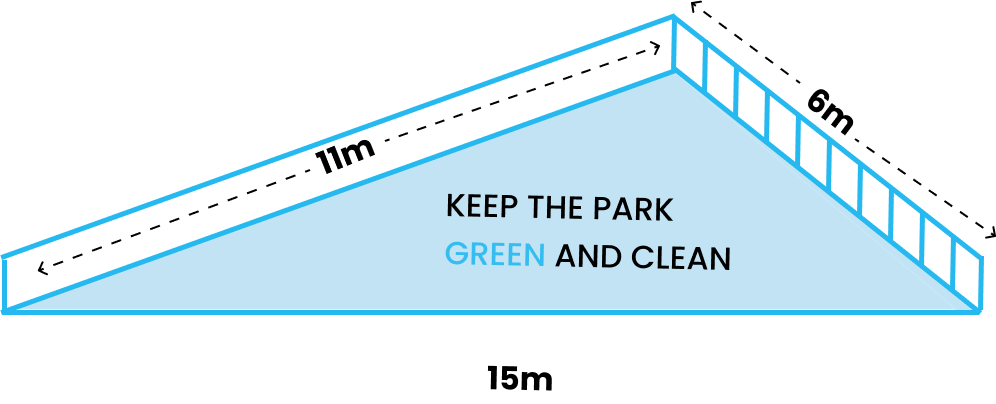NCERT Solutions for Maths Chapter 10 Class 9 Heron’s Formula - FREE PDF Download
FAQs on NCERT Solutions for Class 9 Maths Chapter 10 Heron'S Formula
1. How to find altitude in Heron's Formula class 9?
In class 9 maths herons formula , Heron's formula itself doesn't directly calculate the altitude of a triangle. However, it can be used along with the concept of area to find the altitude in a scalene triangle (one with all sides unequal). Here's the process:
Heron's formula gives the area (A) of a triangle with sides a, b, and c as:
A = $\sqrt{s(s-a)(s-b)(s-c)}$
where s is the semi-perimeter (s = (a + b + c) / 2)
The area of a triangle can also be calculated as 1/2 * base * height (where base is the side along which the altitude is drawn, and the height is the altitude itself).
By equating these two expressions for area and solving for the height (h) with base (b) known, you can get the formula for altitude using Heron's formula:
h = 2 * $\sqrt{s(s-a)(s-b)(s-c)}$ / b
2. Is Heron's formula applicable for all triangles in chapter 10 class 9 maths solutions pdf?
Yes, In class 9 ch 10 , Heron's formula is applicable to all triangles, irrespective of their type (scalene, isosceles, or equilateral). As long as you know the lengths of all three sides, you can use the formula to find the area of the triangle.
3. What is the real-life application of Heron's formula?
Suppose you have to calculate the area of a triangular land. What is the probability that the area is of a regular shape? It is impossible that you will come across lands with regular spaces and sizes, and this is where Heron’s formula comes into use. To calculate the area of real-life objects, the best way to find the exact area of the land is to use Heron’s formula.
4. What is Heron's formula?
Triangle is a three-dimensional closed shape. Heron’s formula calculates the area of a triangle when the length of all three sides is given. Using Heron's formula, we can calculate the area of any triangle, be it a scalene, isosceles or equilateral triangle. For example, the sides of a triangle are given as a, b, and c. Using Heron’s formula, the area of the triangle can be calculated by Area = √S (S-a)(S-b)(S-c) where s is the semi-perimeter of the triangle.
5. How do you solve Heron's formula questions?
To solve questions based on Heron’s formula, you need to remember Heron’s formula, Area= Area= √S (S-a)(S-b)(S-c). Here, ‘s’ is the semi-perimeter of the triangle, and a, b, and c are the lengths of the sides of the triangle. The semi perimeter is denoted by S. It can be calculated by using the formula: S = a+b+c/2. By substituting the values given in these formulas, you can calculate the area of a triangle.
6. What is the meaning of s in Heron's formula?
In Heron’s formula, Area = √S (S-a)(S-b)(S-c), where ‘s’ stands for the semi-perimeter of the triangle whose area we need to calculate. Semi-perimeter can be calculated by the given formula: S = a+b+c/2. To learn more about the semi-perimeter and its usage in calculating the area of a triangle, you can download the Vedantu app or check out the official website of Vedantu.
7. What is a Semi-Perimeter?
In Geometry, the Semi-perimeter of any polygon is half of its perimeter. In Class 9, Chapter 12, Heron’s Formula explains the semi-perimeter of a triangle. Semi-perimeter is denoted by ‘s’ in Heron’s formula, which is Area= √s (s-a)(s-b)(s-c) ‘s’ stands for semi-perimeter, which can be calculated by the given formula: s = a+b+c/2, where a, b, and c are the sides of the triangle of which the area has to be calculated.
8. What is a Semi-Perimeter?
In Geometry, the Semi-perimeter of any polygon is half of its perimeter. In Class 9, Chapter 12, Heron’s Formula explains the semi-perimeter of a triangle. Semi-perimeter is denoted by ‘s’ in Heron’s formula, which is Area= √s (s-a)(s-b)(s-c)
‘s’ stands for semi-perimeter, which can be calculated by the given formula:
s = a+b+c/2, where a, b and c are the sides of the triangle of which the area has to be calculated.





































